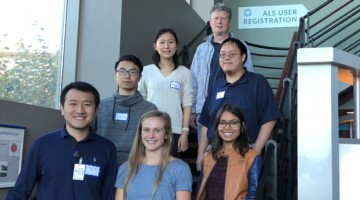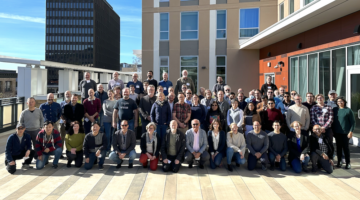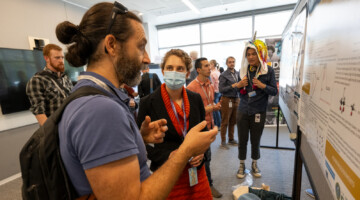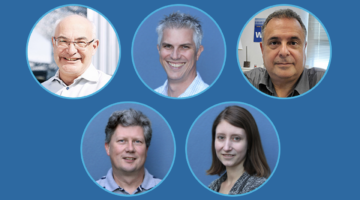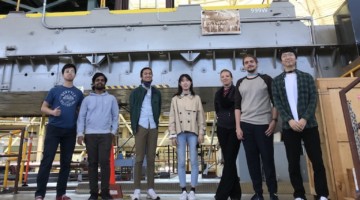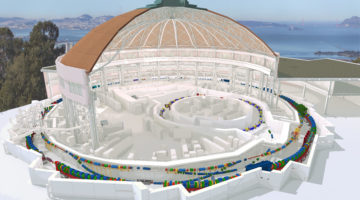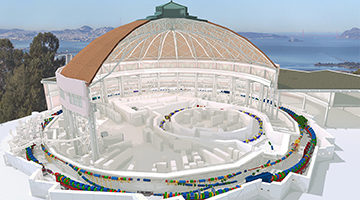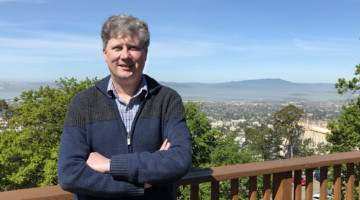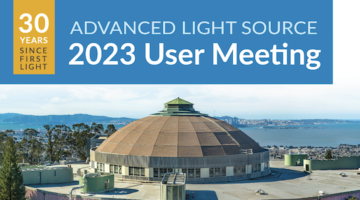Applications will be accepted from March 8–29 for ALS Doctoral and Postdoctoral Fellowships that begin September 1, 2024. Fellows spend a year in residence at the ALS conducting research and instrumentation development in collaboration with their home institution. Read more »
Beamline Staff and Partners Continue Science Visioning Discussions
ALS scientific staff and partners held a retreat on January 11 to continue the strategic planning process. Discussions centered around ideas presented at last September’s User Meeting visioning workshops. Stay tuned for the visioning report and ways you can take part in the future of the ALS!
ALS Hosts Facility Directors’ “6-Way” Collaboration Meeting
Last week the ALS hosted directors and staff from the five DOE-BES light sources and, for the first time, the Oak Ridge neutron sources, turning the traditional “5-way” directors’ meeting into a “6-way.” Discussions covered strategic and operational topics of common interest, spanning data and computing, instrumentation, strategic planning, metrics, user processes, and business and administrative practices.
2023 ALS User Meeting Returned On-Site to Focus on the Future
For the first time in four years, users, staff, and other members of the scientific community gathered in person for the ALS User Meeting. With a new ALS director in place, the 30th anniversary of first light a month away, and ALS-U construction well underway, the occasion was primed to discuss the long-term future of the facility. Read more »
ALS Director Dimitri Argyriou Announces New Leadership Structure
Having seen the success of the interim leadership structure since assuming the ALS directorship in July, Dimitri Argyriou is pleased to announce that Ashley White’s role as interim deputy for strategy is now permanent, and Andreas Scholl’s position as deputy for science will have new responsibilities. Fernando Sannibale and Steve Rossi will continue in their roles as deputy for accelerator operations and deputy for business operations, respectively. Read more »
ALS Postdoctoral Fellowship Program Invites New Applicants
Applications are due October 31 for ALS Collaborative Postdoctoral Fellowships that begin May 1, 2024. Fellows spend a year in residence at the ALS conducting research and instrumentation development in collaboration with their home institution. Read more »
Joint ALS/ALS-U Statement on Dark Time Delay
The ALS-U project recently made an extensive update to its project plan, resulting in a shift in the start of the one-year dark time from October 1, 2025, to June 22, 2026. The updated project schedule will allow the ALS to deliver more beamtime to users before the start of the dark time and further reduces the possibility that the ALS dark time will overlap with the APS’s ramp-up to full operations following their upgrade, currently in progress. Read more »
Dark Time Town Hall Recording and Slides Available
The slides and video recording from the July 20 town hall are now available. The event reviewed what’s currently known about beamline impacts leading up to the dark time, the dark time itself, and the “dawn” period that follows as the facility transitions back to full user operations. Learn more on the recently updated ALS-U part of our website and download the resources from the “Past Events” section of our Events page. Read more »
New Year’s Message from Andreas Scholl
In this new year’s message, Interim Director Andreas Scholl reflects on the last year’s accomplishments, what makes him proud to work at the ALS, and how the community can be involved in shaping the facility’s future. Read more »
Save the Date: 2023 User Meeting & Visioning Workshops
The 2023 ALS User Meeting & Visioning Workshops will be held as a hybrid event September 11–15, 2023. The User Meeting, chaired by Yu He, Wendy Gu, and Devin Grabner, will take place Monday and Tuesday. The second half of the week will offer users, staff, and invited guests the opportunity to shape the facility’s future through visioning workshops. Read more »
- 1
- 2
- 3
- …
- 20
- Next Page »
